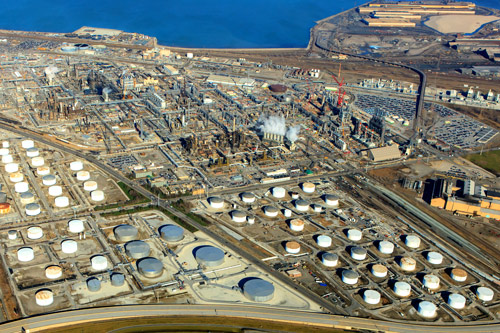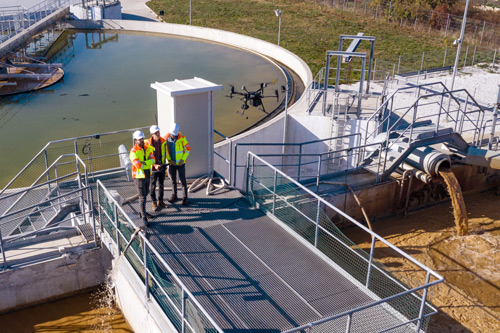Hoosiers live in a world with services that allow them to go about their daily lives comfortably and easily. Electricity, roads, bridges, communications networks and other essential services make up an important part of what are known as Indiana’s “critical infrastructure.” Securing these and other parts of Indiana’s key infrastructure is a priority that requires planning and coordination across the whole community. That is why the Indiana governor's office, IDHS, other state and federal agencies work closely on the Indiana Critical Infrastructure Protection Program (ICIPP).
The ICIPP covers the plan to protect the state's critical infrastructure, which is defined as the systems and assets, both physical and virtual, that are so vital to Indiana that the incapacity or destruction of such systems and assets would have a debilitating effect on security, economic security, public health or safety, or any combination of those matters. These assets provide essential functions and services to communities, counties, districts, the state, neighboring states and, in some cases, the nation.
Presidential Policy Directive 21 (PPD-21) established 16 critical infrastructure sectors (detailed below). In Indiana, up to 85% of critical infrastructure is estimated to be owned and operated by the private sector, with some portion owned by federal, state and local governments. Even if these assets are not thought to be critical to the nation or region, they still may be critical to the state or local governments. Critical infrastructure partners may perceive their criticality differently, based on their unique situations, operating models and associated risks. There are also sites that are very important to the state's prosperity and the safety and confidence of the population, even if they may not be significant otherwise. IDHS works with partners at all levels to develop efforts to protect these sites as part of the ICIPP.
Critical infrastructure and key-resource sites are a subset of critical infrastructure locations that are deemed crucial in terms of public health/safety, governance, economic and national security, and public confidence. These sites may be potential terrorist targets and are located in areas at risk for natural hazards. Effective protection, response, recovery and mitigation efforts rely on joint creation, implementation and maintenance of plans that IDHS helps with.
IDHS planning efforts include:
- Acting as a focal point for and promoting the coordination of protective and emergency response activities, preparedness programs and resource support among local jurisdictions and regional partners
- Developing a consistent approach to site identification, risk determination, mitigation planning and prioritized security investment, as well as exercising preparedness among all relevant stakeholders
- Identifying, implementing and monitoring a risk management plan and taking corrective actions as appropriate
- Participating in significant national, regional and local awareness programs to encourage appropriate management and security of cyber systems
- Acting as a conduit for requests for federal assistance when the threat or current situation exceeds the capabilities of state, local and private entities
- Fostering the exchange of information, including threat assessments, warnings and advisories
- Sharing critical information to protect priorities and restore community lifelines
- Addressing unique geographical issues, including trans-border concerns, dependencies and interdependencies among the critical infrastructure sectors


Critical Infrastructure Sectors
The IDHS critical infrastructure planner is charged with coordinating with the following sectors' owners, operators, systems, etc., for collaboration efforts on P3, BEOC and ESF14.
- Chemical: Four main segments: basic, specialty, agricultural, consumer product.
- Commercial Facilities: Eight subsectors: entertainment and media, gaming, lodging, outdoor events, public assembly, real estate, retail, sports leagues. Most privately owned.
- Communications: Industry using terrestrial, satellite and wireless transmission systems. One of the core four sectors. Most privately owned.
- Critical Manufacturing: Four industries serve as the core: primary metal; machinery; electrical equipment, appliance, and component; and transportation equipment.
- Dams: Critical water retention and control services. Includes hydroelectric power generation, municipal and industrial water supplies, agricultural irrigation, sediment and flood control, river navigation for inland shipping, industrial waste management and recreation. About 65% privately owned.
- Defense Industrial Base: Research and development, production, delivery and maintenance of military weapons systems, subsystems and components or parts. Companies and manufacturing can include foreign entities.
- Emergency Services: Law enforcement, fire and rescue services, emergency management, emergency medical services (EMS), public works, hazmat teams, tactical ops teams, dive teams, aviation units, search and rescue teams, fusion centers.
- Energy: Electricity, petroleum and oil, natural gas. Virtually all sectors have some dependence on the energy sector.
- Financial Services: The largest institutions, smallest community banks, credit unions, investment organizations, insurers, credit organizations. Most privately owned. One of the core four sectors.
- Food and Agriculture: Farms, restaurants, food manufacturing, processing, storage facilities. Accounts for a significant portion of Indiana’s economic activity. Most privately owned.
- Government Facilities: General-use office buildings, special-use military installations, embassies, courthouses, national laboratories and structures that house critical equipment, systems, networks and functions, education, elections.
- Healthcare and Public Health: Hospitals, nursing facilities, doctors’ offices. Most privately owned.
- Information Technology: Hardware, software, services, networks, internets. Dependencies from other sectors are staggering.
- Nuclear Reactors, Materials and Waste: Generation plants, supplies, waste products.
- Transportation Systems: Aviation, highway infrastructure, maritime transportation system, mass transit and passenger rail, pipeline systems, postal and shipping, freight rail. One of the core four sectors.
- Water and Wastewater Systems: Water source, conveyances and distribution systems, raw water storage, treatment, finished water storage, monitoring systems. One of the core four sectors.






